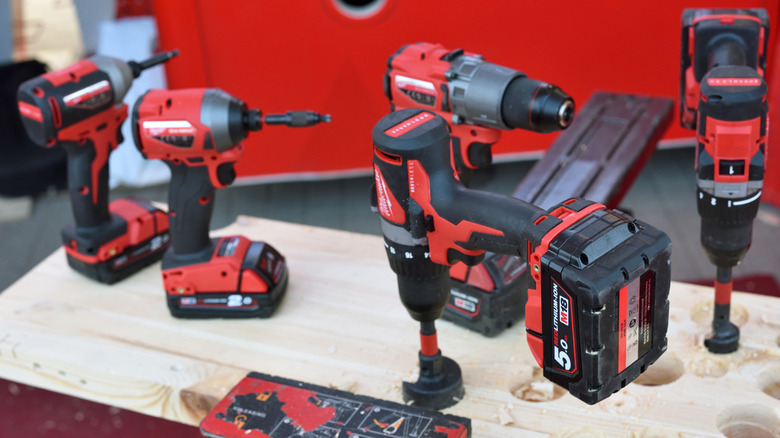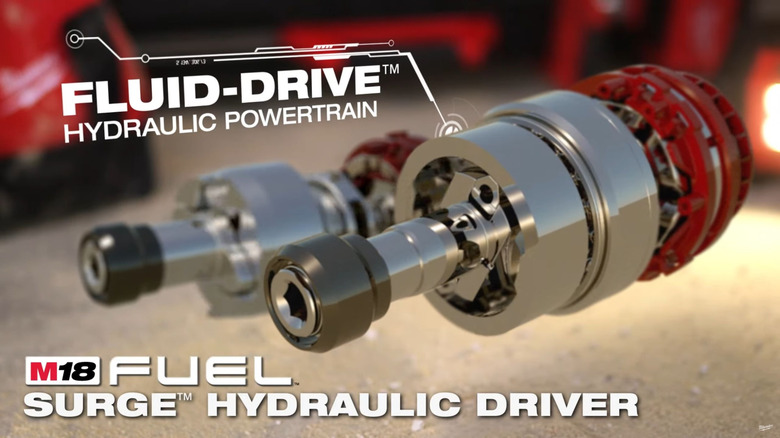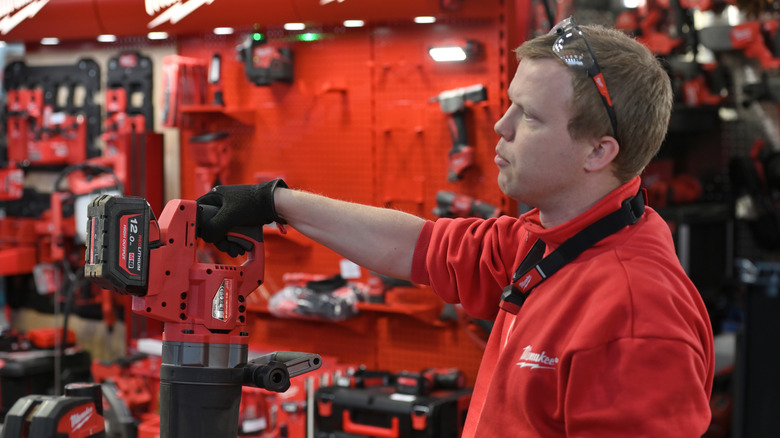Milwaukee FUEL Vs. FUEL SURGE: What's The Difference?
We may receive a commission on purchases made from links.
The process of purchasing any consumer product begins with the age-old battle between buyers in pursuit of the best bang for their buck and marketing folks trying their best to upsell expensive upgrades consumers don't need. Navigating through the seemingly endless barrage of marketing mumbo jumbo to get what you really need is quite the same ordeal in the power tool world.
You'd be right to believe that Milwaukee's FUEL lineup encompasses all manner of power tools driven by efficient brushless motors. But then you also have some plain-vanilla Milwaukee M18 tools incorporating brushless motors, too — all without sporting the FUEL badge. If that wasn't confusing enough, there's the FUEL SURGE line of tools that, quite confoundingly, has nothing to do with underlying motor technology.
Fortunately, the difference between the FUEL and FUEL SURGE tools is pretty straightforward. It ultimately comes down to whether or not you care about sacrificing a bit of power and speed for a significant reduction in NVH levels or noise, vibration, and harshness. However, such gross oversimplification isn't the best way to make an informed decision about your next tool purchase. Let's understand how the FUEL SURGE tools minimize NVH and unpack how all of it factors into your choice between the two Milwaukee tool systems for your specific use case.
How Milwaukee FUEL SURGE drivers differ from FUEL impact drivers
In the simplest of terms, the FUEL SURGE technology upgrades traditional Milwaukee M12 and M18 FUEL impact drivers with a quieter and more refined hydraulic power delivery system. That also means, as of this writing, the FUEL SURGE suffix is restricted to impact drivers, which tend to generate uncomfortable levels of NVH while driving massive lag bolts into dense materials with ease.
A traditional impact driver works by channeling violent torque impulses to drive the most stubborn of fasteners by hammering a rotating anvil dozens of times per second — all without the operator encountering any kickback. The inherent metal-on-metal violence of this process, however, requires the operator (and everyone within earshot) to use hearing protection, in addition to other essential safety equipment. Moreover, the harsh vibrations produced by impact drivers also put the operator at risk of fatigue and potential nerve damage associated with long-term usage.
Milwaukee FUEL SURGE technology employs what it describes as the FLUID-DRIVE hydraulic powertrain, which leverages the rapid expansion and compression of hydraulic fluid to drive fasteners with a significantly improved level of refinement. The inherent dampening nature of hydraulic fluid within the SURGE driver tools acts like a cushion, which makes them easier on the ears, while also reducing vibration transferred to the operator. Milwaukee claims that the softer hydraulic drive system also reduces wear and improves the longevity of the FUEL SURGE drivers.
Milwaukee FUEL SURGE: Comfort comes at a cost
There are no free lunches when it comes to engineering, and the FUEL SURGE impact drivers are no strangers to this phenomenon. What these hydraulic drive tools gain in NVH refinement, they give up in the way of reduced torque and speed at which fasteners are driven compared to traditional FUEL impact drivers.
To put this into perspective, the 1/4-inch M18 FUEL SURGE impact driver can only muster up 450 in-lb of peak torque compared to its traditional non-hydraulic drive counterpart, topping out at a substantial 2,000 in-lb. While that sounds like a massive disparity in the tools' ability to drive fasteners, this doesn't necessarily translate linearly into practical performance. The difference in torque shouldn't feel as significant as the numbers suggest while screwing fasteners appropriately sized for a 1/4-inch impact driver.
Having said that, driving large-diameter fasteners deeper into denser materials will definitely be better with the torquier FUEL impact driver. But at that point, you're better off using a 1/2-inch FUEL driver instead of a 1/4-inch tool — SURGE or otherwise. Not surprisingly, that's also why Milwaukee hasn't bothered to incorporate the SURGE hydraulic drive system in its 1/2-inch impact driver lineup.
In addition to being quiet and comfortable, the low torque FUEL SURGE impact drivers are great for driving Phillips head screws gently without stripping them. You're better off considering these hydraulic impact drivers as specialized tools that can be used in conjunction with a traditional impact driver reserved for heavy-duty tasks.
Who should choose the FUEL SURGE drivers over FUEL impact drivers?
Fortunately, the compromise that the FUEL SURGE impact drivers make in terms of speed and torque happens to be ideal for applications such as electrical installations and finer cabinetry work, where traditional impact drivers may potentially damage delicate MDF boards and electrical switchboards. This makes the smaller Milwaukee M12 FUEL SURGE driver especially ideal for smaller electrical and carpentry tasks where a light touch and granular speed control are preferable.
On the flip side, a loud construction site makes it easier to choose the superior torque output of the Milwaukee M18 FUEL impact driver despite its high operating noise ceiling. In fact, the quieter FUEL Surge power tools are more suited to carpentry and electrical jobs in sites such as homes and offices where traditional impact drivers tend to be a disturbance to occupants.
The choice between the Milwaukee FUEL and FUEL SURGE tools is fairly uncomplicated. Those working in noisy sites, such as construction, metalwork, and framing jobs where high torque is a priority, should invest in FUEL tools. Lighter-duty tasks such as cabinetry and electrical work in sites populated by clients are best suited for the quieter and more delicate FUEL SURGE tools.



